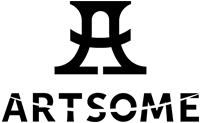
Types & Identifying Tips of Cowhide Leather
- By:ARTSOME
- 2022-08-06
- 370
For consumers, the upholstery is the most importance things of a vintage leather sofa. Different from clothes, shoes, hats and bags, 99 present of the leather used in furniture production is cowhide, because a larger size can meet the needs of designers for more complex and diverse modeling. Artsome leather is top grain cow hide leather covering the finishes of aniline or semi-aniline, which comes from Italy. Cowhide leather is an exceptional material. It’s flexible, timeless in style and can withstand decades of use. But these defining features only apply when you invest in the right type of leather.
Understanding how each impacts leather’s durability and strength will allow you to make informed decisions when purchasing the Neo Art Deco Furniture. Types of cowhide leather can be broken down into several different categories. We can look at the types of cuts, leather qualities, leather grades, leather finishes, types of leather by animal, types of leather with fur, even types of faux and vegan leather. There are some major differences between them.
1. Types of Cowhide Leather
1.1 Types of Cuts of Cowhide Leather
Cowhide can be divided into multiple layers (up to 8 layers). The outermost layer for the first layer of skin is the best quality, followed by the second layers of skin, which strength, elasticity and permeability are not as good as the first layer of skin.
1.1.1 Whether it is processed
All are genuine leather, but the difference between the second layer cowhide and the first layer cowhide is that the second layer cowhide is processed by chemical material spraying or coating film processing.
1.1.2 The tightness of the fibers
The fibers of the first layer are relatively dense and have good elasticity, and the second layer is relatively loose because it has been processed.
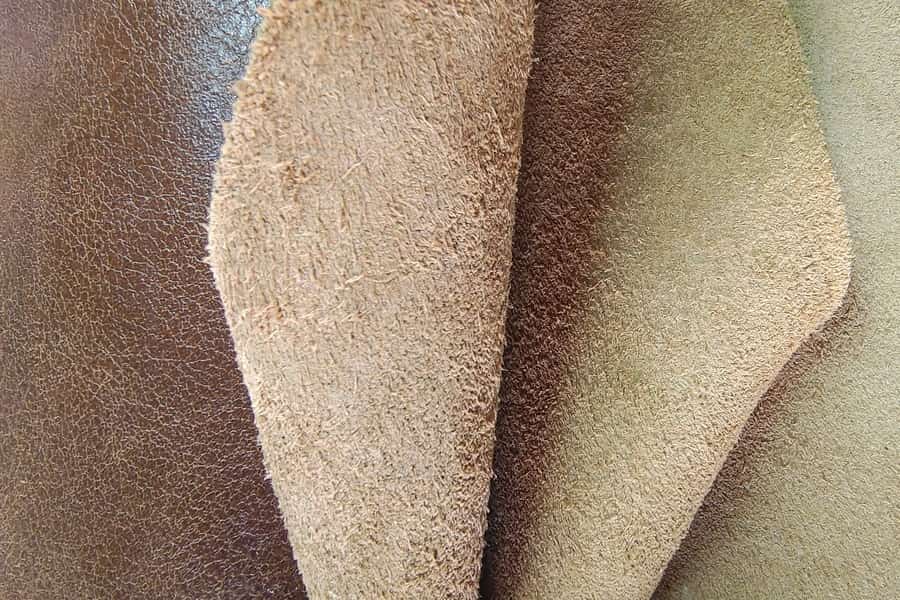
1.1.3 Thickness of cowhide
The thickness of the first layer of cowhide is about 1.3 mm, the second layer is about 1.68 mm, and the pores of the first layer of cowhide can be seen.
1.1.4 Price
The price of the first layer of cowhide is also relatively high, because of its high-quality elasticity. It can be used for daily leather shoes and other leather products.
1.1.5 The degree of beauty
The second-layer cowhide is more beautiful because it is processed.
1.2 Types of Cowhide Leather Qualities
1.2.1 Full Grain Leather
Full grain leather is made of the cow hide, essentially keeping everything but the hair and flesh. This results in a thicker, heavier material that creates extremely durable classic leather sofa.
By keeping the outer layer, full grain leather also preserves the cowhide’s natural grain. From every scratch to scrape, each mark is celebrated making every piece unique. Its quality is the best your money can buy and unlike any other grade of leather, it only gets better with age.
1.2.2 Top Grain Leather
This cut is very similar to full-grain, except that it has had the very top layer sanded and/or buffed to remove imperfections and irregularities in the finish. This makes the leather softer and more pliable, with various dyes and finished applied to it.
While this sanding makes it more visually appealing, it also removes a lot of the strength and some water-repellent qualities of full grain leather. This we begin to see a tradeoff between leather strength, and leather look and softness. Given its softness and flexibility, top grain leather is often used in high end leather goods, such as Artsome vintage leather sofa and chair.
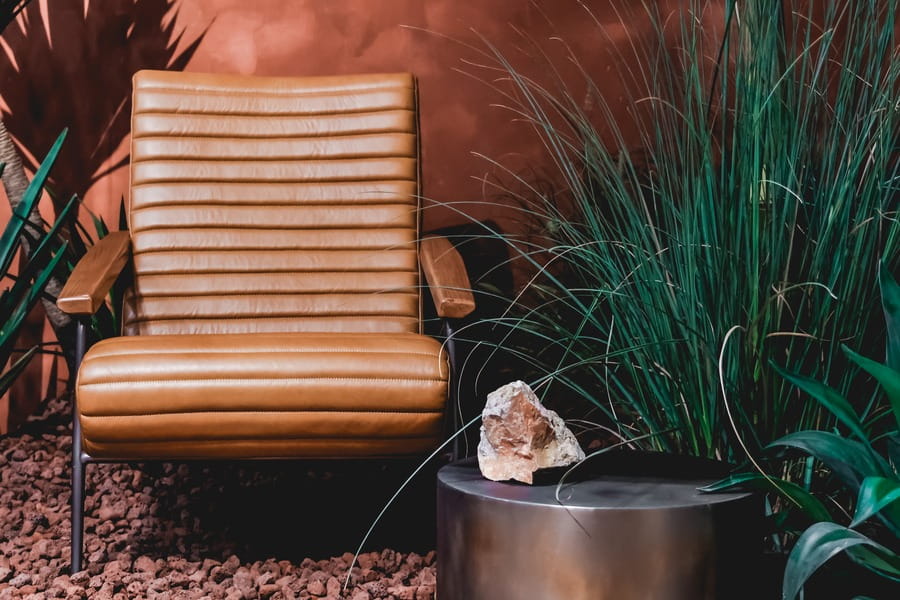
1.2.3 Genuine Leather (Corrected Leather)
Genuine may sound like the best option but is in fact the opposite. The other name for genuine leather is corrected-grain leather, as it is sanded down to remove inconsistencies before being dyed or painted. This often results in a thinner, weaker material used for cheaper leather goods such as belts.
1.2.4 Split-grain Leather
Split grain leather is a layered cut of leather from within the lower levels of the top grain area of the cowhide. It is usually a lower layer of the cowhide, above the flesh. Also, below the full grain and the best top grain cuts. Though, it still provides a useful leather material.
The natural surface of split grain leather is not as dense, tight, and useful as full grain and top grain. Thus, it is often used in finishes of leathers that are colored, embossed, and the surface altered in some significant way. This allows it to offer some of the helpful qualities of a leather material, while having a visually pleasing and often-functional surface beneficial for leather products.
1.2.5 Bonded Leather
Bonded leather (also known as composition or blended leather) is made from scraps of leather fibers mixed with rubber or polyurethane binding materials. It is then embossed with a leather texture to give the appearance of a certain grain.
1.3 Types of Cowhide Leather Finishes
The cow leather finish is part of the finishing process but does not encapsulate the entirety of the finishing process. Instead a cow leather finish refers to the final topcoat or technique used on the cow leather before completing the project.
A cow leather finish can refer to a mechanical technique used to change the appearance of a vintage leather sofa, a protective chemical layer, or a specific dying process used. The finish will affect the appearance of the cow leather’s grain, the uniformity and vibrancy of color, and the sturdiness of your Neo Art Deco furniture. Following are commonly used for upholstery and other home furnishings.
1.3.1 Aniline
Aniline, also known as “naked leather”, is one of the most minimalist leather finishes that can be used high end home furniture. Aniline cow leather is treated with transparent, soluble Aniline dyes. It is colored with dye only. These dyes allow the cow leather’s natural grain to shine through, including any character marks that may be present in the cowhide. The pores of the cow leather are not sealed, so the cow leather still breathes and will obtain a patina. Because this cow leather is all natural, it is somewhat less protected and therefore more vulnerable to spill and stain.
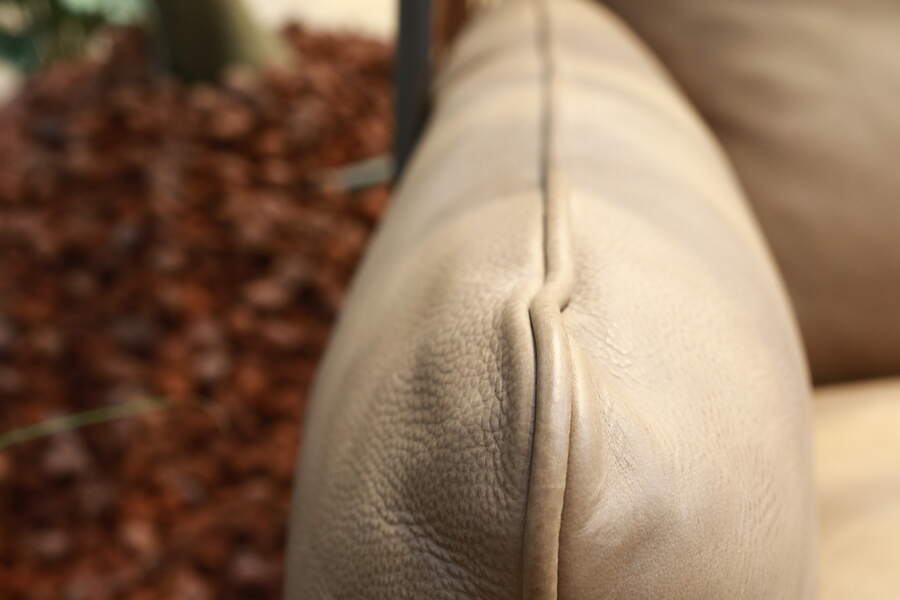
1.3.2 Semi-Aniline
Semi-aniline is one step below aniline regarding quality but is still highly regarded by most artisans and commercial factories. Semi-aniline cow leather is treated with a primer followed by a thin layer of pigmented dye. This dye allows the majority of the natural grain to be showcased while creating a more uniform color distribution. The protective topcoat is thin enough that it does not cover the grain, but is an additional protection. The pigment and topcoat make semi-aniline much more durable and suitable for hard-use items than aniline leather.
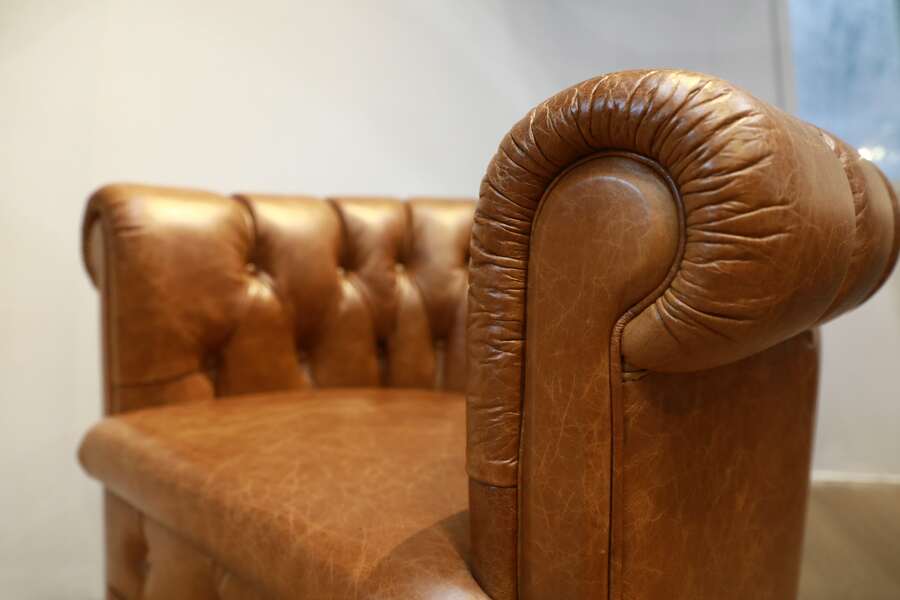
1.3.3 Nubuck (Buffed)
Nubuck leathers are pure aniline hides which are buff sanded for a slight nap effect. The buffing removes the hair cell layer making the cow leather soft but also vulnerable to stains as it has no protection. No pigment is applied to the cowhide so color variation and some natural markings are visible. It has a soft and velvety surface and is some of the most expensive cow leather to purchase.
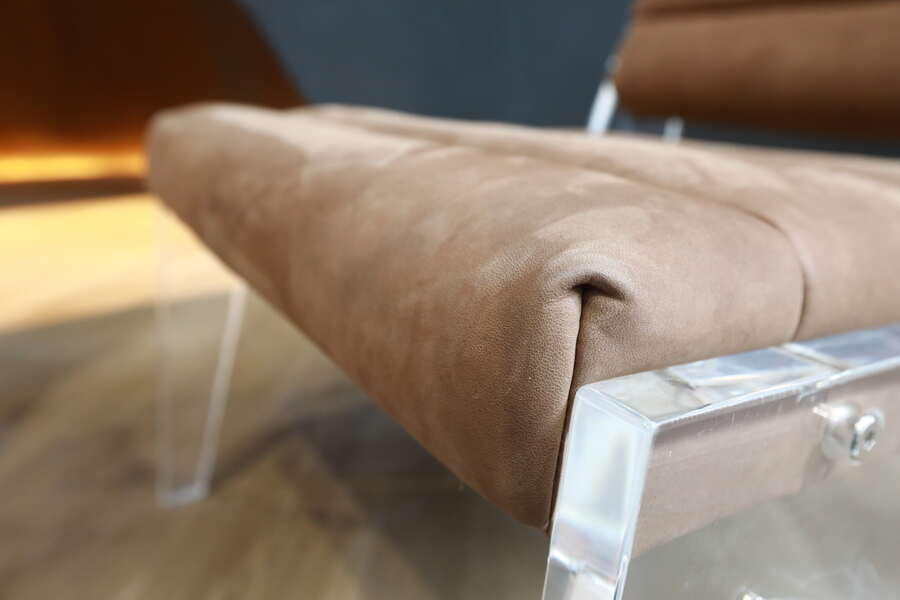
1.3.4 Antique(Oil Pull-up)
It is a type of aniline leather that has an extra top treatment of oil. After the lighter primer has dried, it is wiped by hand with a dark dye, creating dramatic highlights in the finished product. It has properties similar to aniline, but where it is used heavily, the oil is pushed away, leaving lighter areas, especially in the seating area.
1.4 Regions of Cowhide Leather Production
Cowhide is a by-product of animal husbandry. Different cattle breeds, different breeding sites, and different breeding methods will lead to large differences in cowhide. The world’s main rawhide comes from five major regions like America, Central and South America, Europe, Australia and Africa.
a. America
The United States is the world’s largest exporter of cowhide. Because most cattle in American are centralized confinement, commercial breeding with suitable environment and advanced slaughtering methods (mostly machine skin), the United States raw cattle leather supply is stable, high price and quality. Therefore, the raw cowhide are favored by tanneries around the world. The row materials produced in America has a relatively perfect grading standards and trade norms.
b. Central and South America
Brazil is the world’s second largest producers of cowhide in this region. In addition, Argentina, Uruguay, Venezuela, Mexico are also relatively important production areas of medium and low grade cowhide. Due to the hot and humid climate of the region and the environment of grazing in the tropical jungle, the surface of the rawhide produced in this region has obvious thorns and scratches, which are mainly scratched by prickly flowers and trees. And it also has many marks, which are caused by the bites of gadflies and lice. These defects will greatly reduce the integrity of the rawhide, the utilization and use of surface , and directly affect the commercial value of the rawhide. Therefore, with the exception of Pampas grassland in southern Argentina, where the climate is suitable and the leather quality is better, the raw leather quality of other countries in this region is in low and medium level. Europe is the world’s most important exporter of rawhide, the main exporters are the UK, Ireland, Belgium, Russia, France, Germany, Portugal and so on.
c. Europe
Europe is the world’s most important exporter of rawhide, and the main exporters are the UK, Ireland, Belgium, Russia, France, Germany, Portugal and so on. Generally speaking, Europe has a suitable climate for grazing and advanced feeding methods, so the German, British and French raw cowhides in the region are better raw materials for leather production. Belgium, Portugal and Ireland pale in comparison. In Russia and Eastern Europe, because of the differences in breeding methods and geographical climate, the price is low and the quality is poor, but the production is large. Europe has a traditional history of leather trading. Many raw skin traders in Italy, Britain and Russia have been buying raw cowhides for years and curing and grading them in Italy or Russia before selling them all over the world.
d. Australia
This region is an important producer of cattle hide in the Southern Hemisphere. Australia has a large export volume of cowhide and occupies an important share in the world trade. Australia is a vast country with few people and different natural environments, so the prices of cowhide vary greatly.
e. Africa
This region is the world’s main producer of low-grade rawhide. The cowhide is generally scarred by cuts, stings, gadflies and lice, because of the influence of natural grazing, numerous tropical forests, hot climate, artificial skin peeling and other factors. And most of the cattle have humps. In addition, due to the residual influence of colonies, the trade, import and export of African rawhide are still controlled by some European traders so far, and the trade is chaotic.
When we buy a cowhide leather sofa, we can often see the origin of Brazil, Italy and Germany, which may be the origin of raw cowhide, or the origin of finished cowhide products.
2. How to Identify Real Cow Leather
2.1 Check the label.
Real cow leather is the label that you need to look for. Opt for the labels “100% real cow leather”, “full-grain/top grain” or even “genuine leather”. But keep in mind that genuine cowhide leather is a natural material of the poorest quality. Fake leather materials are labeled as “man-made”.
2.2 Look up real close.
Real cowhide leather has a structure with natural blemishes and imperfections, despite polishes. Real cow leather also has clear hair and patterns, like yellow cow skin has more symmetrical fine pores; yak skin has thicker and sparse pores; goatskin has fish-like pores. Fake leather is a machine-made fabric that has a very smooth surface.
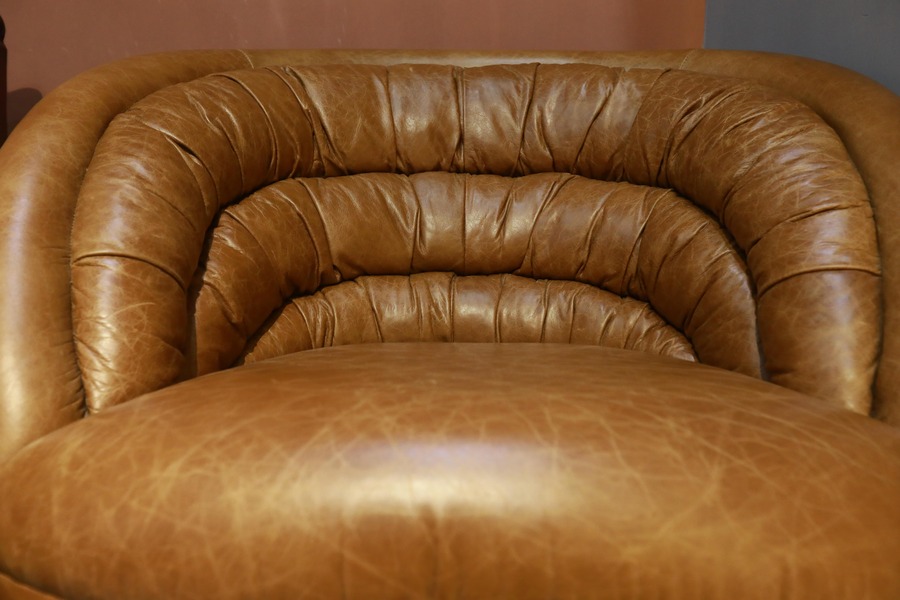
2.3 Touch the leather.
Real cow leather won’t feel perfectly smooth to the touch but will fell soft and elastic. Pressing the fingers into the leather material, you will find that the surface may wrinkle and stretch a bit. On the other hand, fake leather feels cold and unnaturally smooth. It won’t stretch or wrinkle.
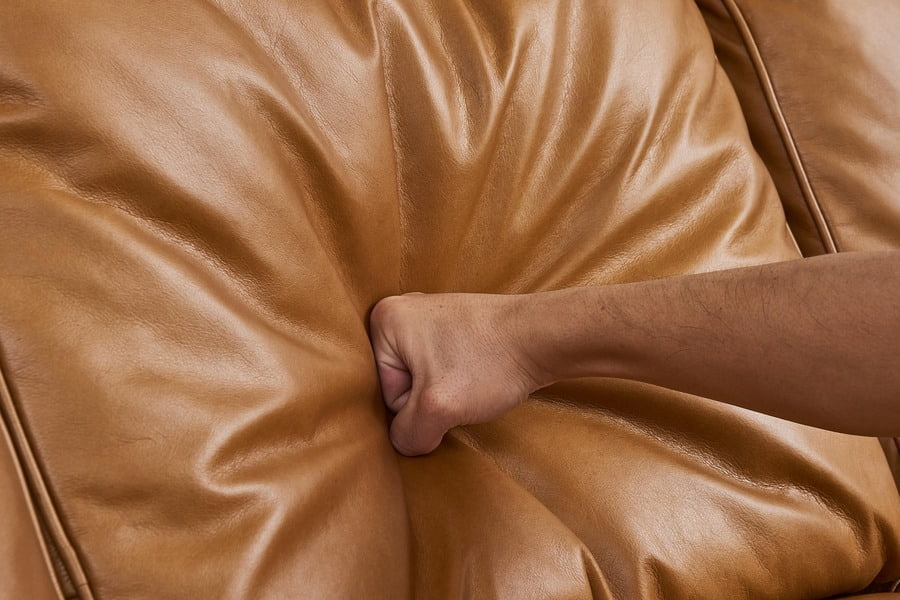
2.4 Smell the leather.
Only the natural material will have a distinctive “leather” smell. Faux leather won’t have such an organic smell but has a strong pungent plastic odor.
2.5 Ignite the leather fiber.
Tear off a little fiber from the back of real cow leather and artificial leather, and ignite them. If the smell is pungent, that is artificial leather. Any hair smell, which is real cow leather.
The natural characteristics of real cowhide leather are:
- Thickness
- Water-resistance
- Soft and supple
- Marks, scars and variations
- Wrinkles and creases with use
-
The Exhibition – Canton Fair 2025 (April)
2025-04-09 -
The Exhibition – The 55th CIFF Guangzhou
2025-03-04 -
New High Back Elephant’s Ear Sofa
2025-02-12 -
Sophisticated Dining Set with Ash Wood Frame and Green Leather Chairs
2025-01-16 -
Merry Christmas & Happy New Year
2024-12-25 -
Luxury King Size Bed
2024-12-23 -
White Linen Cloud Sectional Sofa: A Symphony of Comfort and Style
2024-11-28 -
Stainless Steel Furniture — Kalas Desk And Saddle Leather Chair
2024-11-04 -
Versatile and Stylish Storage Solutions: The Elegance of Wooden Trunk Designs
2024-10-16 -
The Exhibition: Canton Fair 2024 (Autumn)
2024-09-28
-
Egg Chair & Swan Chair, the Iconic Symbol of Scandinavian Design
2023-11-13 -
Vanity Fair Sofa, the Luxurious and Stylish Furniture
2023-10-04 -
A Guide for Modern Metal Furniture
2023-08-15 -
Introduction of Modern Furniture Material — Acrylic and Glass
2023-07-15 -
The Structure & Materials of Artsome Leather Sofa
2022-12-16 -
Modern Furniture Finishes & Furniture Care Tips
2022-11-14 -
How to Design the Modern Furniture Sofa
2022-10-02 -
Tips for Looking for a Quality New Bed
2022-09-13 -
Tips for Mid-Century Modern Furniture Placement
2022-08-19 -
Types & Identifying Tips of Cowhide Leather
2022-08-06























